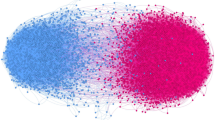Abstract.
We analyze a simple opinion formation model consisting of two parties, A and B, and a group I, of undecided agents. We assume that the supporters of parties A and B do not interact among them, but only interact through the group I, and that there is a nonzero probability of a spontaneous change of opinion (\(A \leftrightarrows I\), \(B \leftrightarrows I\)). From the master equation, and via van Kampen's Ω-expansion approach, we have obtained the “macroscopic” evolution equation, as well as the Fokker-Planck equation governing the fluctuations around the deterministic behavior. Within the same approach, we have also obtained information about the typical relaxation behavior of small perturbations.
Similar content being viewed by others
References
W. Weidlich, Sociodynamics-A systematic approach to mathematical modelling in social sciences (Taylor & Francis, London, 2002)
W. Weidlich, Phys. Rep. 204, 1 (1991)
D. Stauffer, S. Moss de Oliveira, P.M.C. de Oliveira, J.S. Sa Martins, Biology, Sociology, Geology by Computational Physicists (Elsevier, Amsterdam, 2006)
D. Stauffer, Physica A 336, 1 (2004
S. Galam, Physica A 336, 49 (2004)
S. Galam, B. Chopard, A. Masselot, M. Droz, Eur. Phys. J. B 4, 529 (1998); S. Galam, J.-D. Zucker, Physica A 287, 644 (2000); S. Galam, Eur. Phys. J. B 25, 403 (2002); S. Galam, Physica A 320, 571 (2003)
G. Deffuant, D. Neau, F. Amblard, G. Weisbuch, Adv. Complex Syst. 3, 87 (2000); G. Weisbuch, G. Deffuant, F. Amblard, J.-P. Nadal, Complexity 7, 55 (2002); F. Amblard, G. Deffuant, Physica A 343, 453 (2004)
R. Hegselmann, U. Krausse, J. of Artif. Soc. and Social Sim. 5, 3 (2002)
K. Sznajd-Weron, J. Sznajd, Int. J. Mod. Phys. C 11, 1157 (2000); K. Sznajd-Weron, J. Sznajd, Int. J. Mod. Phys. C 13, 115 (2000); K. Sznajd-Weron, Phys. Rev. E 66 046131 (2002)
F. Slanina, H. Lavicka, Eur. Phys. J. B 35, 279 (2003)
M. He, Q. Sun, H. Wang, Int. J. Mod. Phys. C 15, 767 (2004)
D. Stauffer, A.O. Souza, S. Moss de Oliveira, Int. J. Mod. Phys. C 11, 1239 (2000); R. Ochrombel, Int. J. Mod. Phys. C 12, 1091 (2001); D. Stauffer, Int. J. Mod. Phys. C 13, 315 (2002); D. Stauffer, P.C.M. Oliveira, Eur. Phys. J. B 30, 587 (2002)
D. Stauffer, Int. J. Mod. Phys. C 13, 975 (2002)
D. Stauffer, J. of Artificial Societies and Social Simulation 5, 1 (2001); D. Stauffer, AIP Conf. Proc. 690 (1), 147 (2003); D. Stauffer, Computing in Science and Engineering 5, 71 (2003)
C. Castellano, M. Marsili, A. Vespignani, Phys. Rev. Lett. 85, 3536 (2000); D. Vilone, A. Vespignani, C. Castellano, Eur. Phys. J. B 30, 399 (2002)
K. Klemm, V.M. Eguiluz, R. Toral, M. San Miguel, Phys. Rev. E 67, 026120 (2003); K. Klemm, V.M. Eguiluz, R. Toral, M. San Miguel, Phys. Rev. E 67, 045101R (2003); K. Klemm, V.M. Eguiluz, R. Toral, M. San Miguel, J. Economic Dynamics and Control 29, (1, 2), 321 (2005)
P.L. Krapivsky, S. Redner, Phys. Rev. Lett. 90, 238701 (2003)
M. Mobilia, Phys. Rev. Lett. 91, 028701 (2003); M. Mobilia, S. Redner, e-print arXiv:cond-mat/0306061 (2003)
C. Tessone, P. Amengual, R. Toral, H.S. Wio, M. San Miguel, Eur. Phys. J. B 25, 403 (2004)
M.F. Laguna, S. Risau Gusman, G. Abramson, S. Gonçalves, J.R. Iglesias, Physica A 351, 580 (2005)
J.J. Schneider, Int. J. Mod. Phys. C 15, 659 (2004), J.J. Schneider, Ch. Hirtreiter, Physica A 353, 539 (2005), J.J. Schneider, Ch. Hirtreiter, Int. J. Mod. Phys. C 16, 157 (2005)
F. Vazquez, P.L. Kaprivsky, S. Redner, J. Phys. A 36, L61 (2003); F. Vazquez, S. Redner, J. Phys. A 37, 8479 (2004)
P. Babinec, Phys. Lett. A 225, 179 (1997)
M.S. de la Lama, J.M. López, H.S. Wio, Europhys. Lett. 72, 851 (2005)
N.G. van Kampen, Stochastic Processes in Physics and Chemistry (North Holland, Amsterdam, 2004), Ch. X; H.S. Wio, An Introduction to Stochastic Processes and Nonequilibrium Statistical Physics (World Scientific, Singapore, 1994), Ch. 1
It is worth commenting that it is convenient to avoid these pathological ranges of parameters that makes Υ= ΨAst + ΨBst to fall within a very thin strip near the frontiers of the physical region (i.e. the region limited by Υ= 1, ΨAst = 0, and ΨBst = 0). In such cases, the tail of fluctuations falling outside the physical region will be too large invalidating the whole approach. Clearly, the parameters choosen for Figure 4 avoid such pathological situation, as the fluctuation tails falling outside the physical region are negligible
C. Schat, G. Abramson, H.S. Wio, Am. J. Phys. 59, 357 (1991)
Author information
Authors and Affiliations
Corresponding author
Additional information
An erratum to this article is available at http://dx.doi.org/10.1140/epjb/e2007-00206-4.
Rights and permissions
About this article
Cite this article
de la Lama, M., Szendro, I., Iglesias, J. et al. Van Kampen's expansion approach in an opinion formation model. Eur. Phys. J. B 51, 435–442 (2006). https://doi.org/10.1140/epjb/e2006-00232-8
Received:
Published:
Issue Date:
DOI: https://doi.org/10.1140/epjb/e2006-00232-8




